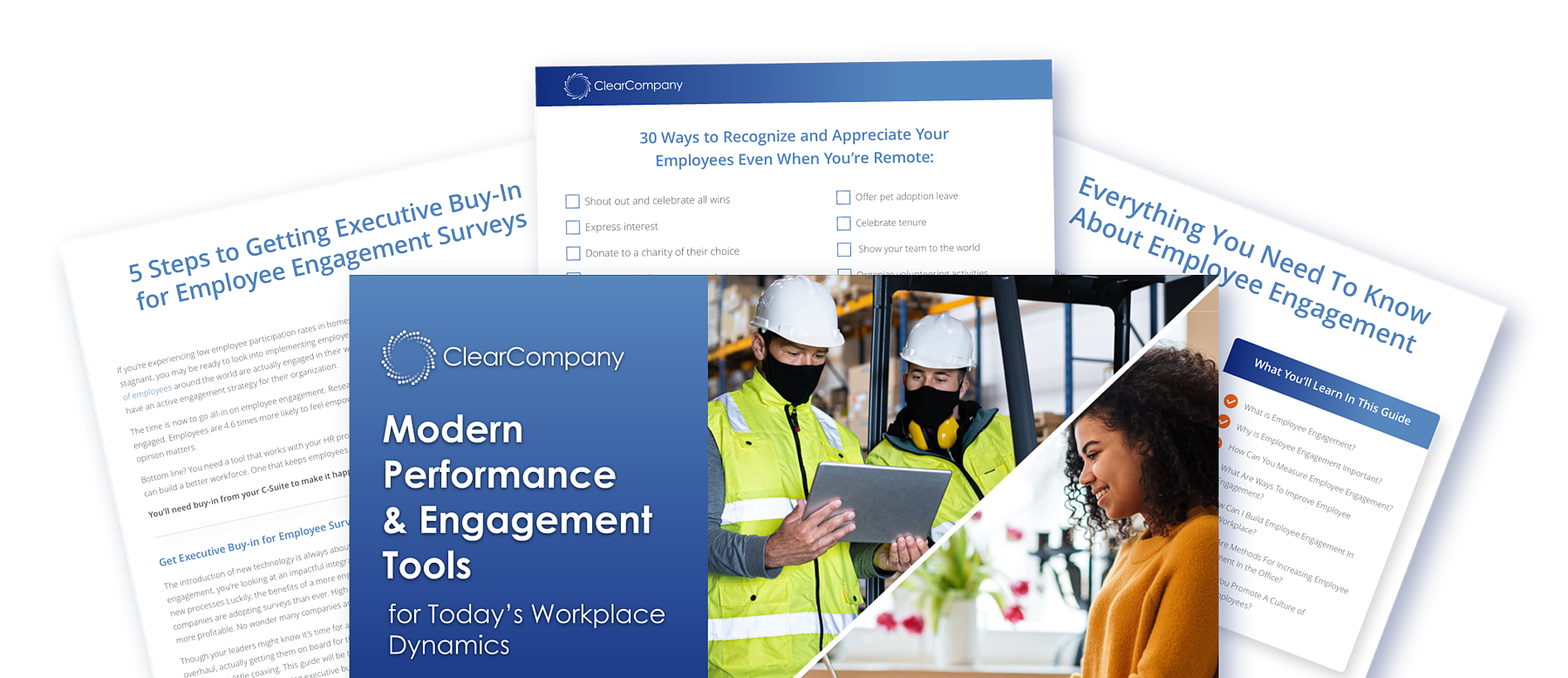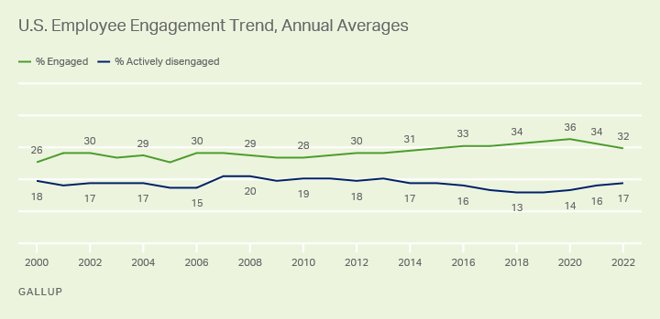Performance management and employee engagement are closely intertwined. Engaged employees are more motivated, satisfied with their jobs, and feel supported to do their best at work. Performance conversations are a chance for managers to motivate team members, gauge employee satisfaction, and make sure employees feel equipped to do their jobs. So, it makes sense that an effective way to improve employee engagement is through your company’s performance management strategy.
Keep reading to find out why employee engagement is so important today. Then, learn about five ways your performance management framework should be driving engagement.
#PerformanceManagement strategy can drive #EmployeeEngagement — but only if you know what employees need to stay engaged. Find out 5 ways a solid performance strategy can drive engagement:Why Driving Employee Engagement Matters Now
A Gallup poll recently found that U.S. employee engagement has declined for the first time in almost ten years, from 36% in 2019 to 32% in the first half of 2022. It’s not necessarily a surprise that engagement has been impacted in light of the workplace disruptions since the onset of the COVID-19 pandemic, from mass layoffs and an immediate switch to remote work to the Great Resignation (or Great Reprioritization) and today’s candidate’s market.
Out With the Old
It’s time for a revamp if you’re relying on traditional annual performance reviews — they’re unpopular with employees and managers alike:
- 95% of managers are dissatisfied with their current review process.
- Just 14% find performance reviews to be motivating.
- Only 13% of employees and managers think that annual reviews are useful.
Though not entirely surprising, the decline in employee engagement shouldn’t be ignored. Disengagement and low engagement lead to losses as high as $500 billion each year. On the other hand, highly engaged employees are an invaluable asset for every business, leading to:
- Up to 21% higher profitability
- Turnover rates up to 31% lower
- 20% increase in sales
Luckily, we have insight into why employee engagement fell. Gallup’s poll showed that respondents’ scores were lower for questions related to:
- Clarity of expectations
- Materials and equipment
- Recognition
- Development Connection
On a positive note, Gallup found that companies that prioritized culture, employee wellbeing, support, and communication were able to maintain 70% average employee engagement. That’s more than double the U.S. average during a time when overall engagement levels were dropping.
Emulate those companies by paying attention to the drivers of employee engagement and what employees say they need more of. Review our list of ways performance management promotes employee engagement to ensure your strategy is effective or find ways to make it even better.
HR Deep Dive: What is Employee Engagement? A Complete Guide
1. Performance Management Provides Clarity
Performance management helps employees understand what’s expected of them on a daily basis and long-term in their roles. Features of a performance management system that provide clarity and guidance include:
- Goal-setting, updates, and feedback
- Weekly check-ins with managers
- Performance review cycles
When they’re getting real-time feedback, collaborating to set new goals, and making plans for their future at your company, employees can work confidently with less confusion about what they need to accomplish. And, they can see your company is invested in their success. This builds trust, promotes a transparent company culture, and keeps employees more engaged.
Did You Know? 43% of highly engaged employees speak with their managers at least once a week.
2. Performance Management Ensures Employees Have Everything They Need to Work
Performance management ensures that employees are set up with the right materials and equipment to get their work done. When meetings are frequent, managers are more in tune with their reports’ projects and can offer additional resources more readily. Employees have the opportunity to ask for materials or equipment they may be missing. Plus, it helps build a strong relationship with their manager where they feel comfortable asking for resources.
Read More: Learn about the different types of performance management systems.
3. Performance Management Leads to Purposeful Employee Recognition
Employee recognition is now an essential part of an engagement-driving performance management program. Though thanks and congratulations may seem like a small gesture, the evidence shows that recognition is a powerful engagement tool:
- Voluntary turnover is 31% lower in companies with a culture of recognition
- 71% of companies with highly engaged employees recognize their good work, compared to 41% of less engaged companies
- 70% of employees say being thanked by their manager is one of the most effective ways to boost morale
Make recognition a purposeful performance and employee engagement strategy by coaching managers to call out good work whenever they see it. Whether it’s a big win, diligent effort, or a milestone anniversary, encourage managers to show their appreciation for their team as often as they can.
One of the benefits of using employee engagement software is that it makes employee recognition as easy as sending a Slack message. ClearCompany’s Shout Outs and Celebrations can help your company make appreciation and thanks an integral part of company culture. They can be sent to a dedicated Slack channel so everyone can take the time to celebrate colleagues’ accomplishments, birthdays, and work anniversaries.
4. Performance Management Plans for the Future
Performance management that plans for the future leads to more engaged, loyal employees and it can also improve performance by up to 13 percent. Forward-looking performance management matters even more to employees post-pandemic: 47% reported feeling anxious about work after COVID-19. Setting long-term goals can help ease that anxiety and gives employees direction in their daily workday.
Recent Gartner research stresses the importance of setting goals that are aligned with business objectives and put in context by managers. Helping employees understand business goals and how their work fits in makes the future a little less mysterious. As an added bonus, it can increase employee performance by 22% and create more high performers at your company.
5. Performance Management Builds Trust
The most effective performance management strategy is one that builds trust with your employees. It should demonstrate to your employees that your organization wants them to succeed and continue to grow. Performance management programs build trust in several ways:
“Trust is like the air we breathe. When it is present, nobody really notices. But when it’s absent, everybody notices.”
- Warren Buffett
- Let employees know what to expect from performance appraisals and give regular feedback
- Allow employees to play an active role in goal-setting and career growth
- Show that your company is committed to long-term employee development
When there’s a high amount of trust in the workplace, there are benefits across the organization:
- 76% more employee engagement
- 50% higher productivity
- 40% less burnout
Trust also fosters collaboration, creativity, and innovation, and encourages employees to better conflict resolution among teams. According to Jen Fisher, U.S. chief well-being officer for Deloitte, trust is the foundation of a healthy work environment and during the uncertainty caused by the pandemic, it takes on new significance.
Link Performance and Engagement to Connect with Employees
You can use software to link employee engagement and performance management and create an even closer connection between the two strategies. Great employee engagement software has tools like employee surveys and recognition programs. The best performance management software contains features including performance reviews and employee goal-setting.
Top software platforms like ClearCompany offer both. Our clients benefit from increased insights, easier process management, and an even wider array of tools and features:
- Measure employee engagement with prebuilt and custom Employee Engagement Surveys
- Review and track employee performance using a variety of expert-built review templates and performance reports
- Collaborate with employees to set goals, get regular updates on their progress, and give timely feedback
Ready to test our Performance and Engagement software for yourself? Get in touch with the ClearCompany experts and schedule a demo today.



